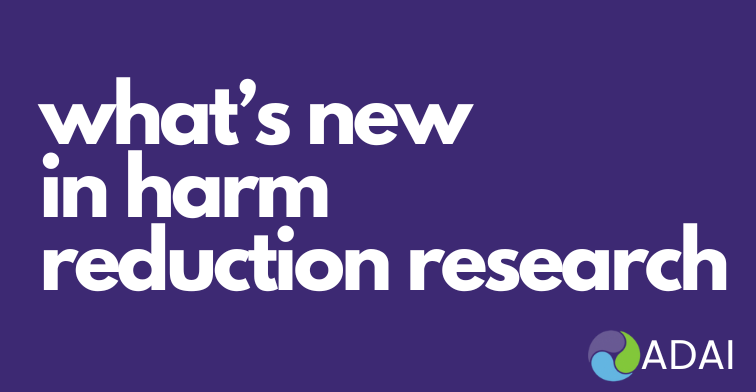What’s New in Harm Reduction Research (December 2024)
12/03/2024A review of recently published research on harm reduction topics – December 2024.
Need help getting copies of any of these articles? Email Meg Brunner, MLIS (meganw@uw.edu). Free articles have “(open access)” after the titles; all other articles require a subscription to access.

Facilitators and barriers to monitoring and evaluation at syringe service programs. (open access)
Healy E, Means AR, Knudtson K, Frank N, Juarez A, Prohaska S, McKnight C, Des Jarlais D, Asher A, Glick SN. Harm Reduct J. 2024 Aug 28;21(1):157.
Key informant interviews were conducted with 12 syringe services program (SSP) staff to describe data systems used by SSPs, understand facilitators and barriers to data collection, and recommend best practices for SSP data collection. Main themes included: SSP monitoring and evaluation (M&E) systems are designed to respond to perceived SSP client needs and preferences; SSP staffing capacity influences the likelihood of modifying M&E systems; funding often forces changes to M&E systems; and strong M&E systems are often necessary to access funding. Findings highlight that SSPs are not resistant to data collection and M&E but face substantial barriers to implementation, including lack of funding and disjointed data reporting requirements.
‘This is PEEP’ participatory qualitative study: learning from a provincial consultation and advisory group of people with lived and living experience of substance use in British Columbia, Canada. (open access)
Daowd K, Lock K, Danaei A, Burmeister C, Choisil P, Haywood E, Henderson I, Lamb J, McDougall J, Sedgemore K, Buxton JA. BMJ Open. 2024;14(11):e085183.
This study describes the outputs and impacts of PEEP’s (Professionals for Ethical Engagement of Peers), a group of consultants with lived and living experience of substance use in British Columbia, Canada. An environmental scan showed that PEEP members are co-authors/acknowledged for their input in 25 peer review publications and 16 reports and that PEEP members co-presented or were co-authors on 33 presentations. Interviews with 8 PEEP members and 9 staff/people who consulted PEEP revealed that: 1) PEEP provides a sense of community, holds systems accountable and inspires others; 2) Consultants should involve PEEP throughout the process and report how PEEP’s insights were used; and 3) PEEP members gained skills and confidence and consultants learned from PEEP.
Stories for Us, or for Others: Digital Storytelling with a Harm Reduction Organization as Culture-Centered Health Communication.
Young R, Dongilli D, Souder A, Peek-Asa C. Health Commun. 2024:1-14.
This is a case study analysis of two 2-day digital storytelling workshops with a local harm reduction organization that supports people who use drugs. Storytellers used digital storytelling to confront stigma and to show how harm reduction work engendered a sense of purpose and an alternative to punitive drug policies. However, storytellers felt that stories produced for the harm reduction community could be misunderstood by outsiders, limiting the potential of the stories for advocacy communication. Digital storytelling has potential to elevate the experiences, understanding, expertise, and goals of communities that have been excluded from health communication.
How do people who use opioids express their qualities and capacities? An assessment of attitudes, behaviors, and opportunities. (open access)
Ezell, J.M., Pho, M.T., Simek, E. et al. Harm Reduct J 2024; 21, 79.
This study used a “strengths-based” lens to interview 46 clients of syringe services programs in New York City and rural southern Illinois to assess respondents’ perceived strengths. A “strengths-based ethos” was found in individuals being an advocate and resource for harm reduction knowledge and practices and acting with agency towards self-actualization. Strengths-based interventions can affirm and leverage personal identity, decision-making capacity, and endemic knowledge.
An economic analysis of the cost of mobile units for harm reduction, naloxone distribution, and medications for opioid use disorder. Castry M, Tin Y, Feder NM, Lewis N, Chatterjee A, Rudorf M, Samet JH, Beers D, Medley B, Gilbert L, Linas BP, Barocas JA. J Subst Use Addict Treat. 2024;167:209517.
This study aimed to estimate the economic costs of starting and maintaining mobile units providing harm reduction, overdose education and naloxone distribution (OEND), and medication for opioid use disorder (MOUD) in four communities in Massachusetts. The largest cost category for all mobile units was personnel costs. Monthly ongoing costs varied by community settings and services. Results provide valuable community-level economic data to stakeholders and policymakers considering establishing and/or expanding mobile units with OEND and MOUD services.
A scoping review on barriers and facilitators to harm reduction care among youth in British Columbia, Canada. (open access)
Beck K, Pallot K, Amri M. Harm Reduct J. 2024;21(1):189.
This scoping review collates peer-reviewed evidence to understand the barriers and facilitators faced by youth who use drugs when accessing harm reduction programming in British Columbia, Canada. Main barriers included self-stigma, service navigation, service delivery, and negative provider interactions. Facilitators included ability to meet basic needs, positive provider interactions, social networks, and risk reduction. Barriers continue to hinder harm reduction engagement, while supportive networks, positive provider interactions, and the ability to meet basic needs facilitated sustained access.
How do relational practices co-constitute care for people who use drugs? The social and political dimensions of peer-led harm reduction. (open access)
Piatkowski T, Seear K, Reeve S, Kill E. Int J Drug Policy. 2024;133:104614.
Semi-structured interviews were conducted with 30 people who use drugs to explore the role of peers in mitigating drug-related harms through community care. Participants highlighted the importance of peer involvement in driving change, promoting safer use practices, bridging gaps in formal services, and offering stigma-free, relational care spaces that affirm dignity and counter marginalization.
A community-academic partnership to develop an implementation support package for overdose prevention in permanent supportive housing.
Gaeta Gazzola M, Torsiglieri A, Velez L, Blaufarb S, Hernandez P, O’Grady MA, Blackburn J, Florick J, Cleland CM, Shelley D, Doran KM. J Subst Use Addict Treat. 2024;168:209533.
This study aimed to refine a set of evidence-based overdose prevention practices (EBPs) and implementation support package for permanent supportive housing (PSH) settings through 16 focus groups with 40 unique participants (14 PSH tenants, 15 PSH staff, 11 PSH leaders). The implementation support package contains an PSH Overdose Prevention (POP) Toolkit with 20 EBPs surrounding overdose prevention and response, harm reduction, and support for substance use treatment and implementation strategies including practice facilitation, tenant-staff champion teams, and learning collaboratives.
Evaluating public health vending machine rollout and utilization in criminal-legal settings.
Martin R, DaCunha A, Bailey A, Joseph R, Kane K. J Subst Use Addict Treat. 2024:209584.
The Rhode Island Department of Corrections implemented public health vending machines in 5 community corrections offices. 3,720 items were dispensed from May 2022 to February 2024. Hygiene kits were the most frequently accessed item, followed by nicotine replacement kits and ponchos. The fentanyl tests, wound care kits, resource guide, naloxone, and safer sex kits each made up between 5-7% of items accessed. Pregnancy tests were the least accessed. Utilization patterns demonstrate the demand for basic supplies and support related to harm reduction.
Reaching people who use drugs with sexual and reproductive healthcare through syringe services programs: potential promise and missed opportunities. (open access)
Scheidell JD, Chueng T, Ciraldo K, Hervera B, Dakoulas S, Mahachi M, Bennett AS, Elliott LC. Harm Reduct J. 2024 Nov 14;21(1):198.
This nested cross-sectional study (n=120) examines how use of a New York City syringe services program (SSP) and differences in sexual and reproductive health may vary within intersecting gender, racial, and ethnic groups, and by injection drug use (IDU). SSP use was disproportionately low among Black participants irrespective of gender or IDU. Women reporting SSP use had a higher prevalence of sex partners, history of STI symptoms, and lack of effective STI prevention, compared with women who did not use SSP. Among men, sexual and reproductive health varied across racial and ethnic groups but not as clearly by SSP use. SSPs can address elevated STI risk among people who use drugs but may miss certain intersecting gender, race, and ethnic groups.
Are virtual harm reduction interventions right for everyone?: A qualitative study of the appropriateness of overdose response hotlines and applications for different subgroups of people who use substances.
Teare A, Rioux W, Rider N, Jones S, Taplay P, Ghosh SM. J Subst Use Addict Treat. 2024;168:209567.
Overdose response hotlines and apps are novel virtual harm reduction technologies that allow remote monitoring of individuals while they use substances (especially if they use alone) through electronic means. The study conducted 64 semi-structured interviews with participants with a range of substance use experience to determine which groups of people who use substances (PWUS) these services would be most appropriate for, and how to best target these technologies. Results showed that overdose response hotlines and apps would potentially have at least some utility for any PWUS, although this varied among the 11 different subgroups identified.
List compiled by Susan Kingston
View previous reviews





